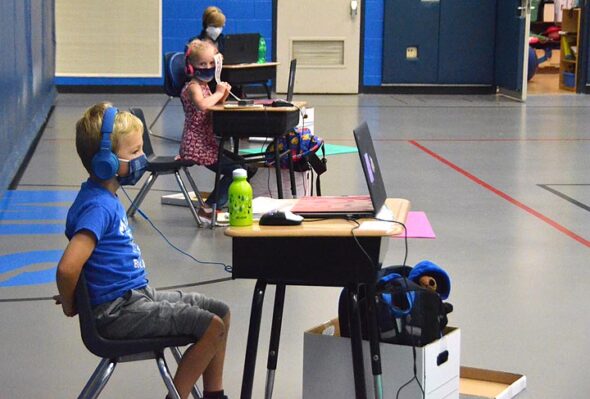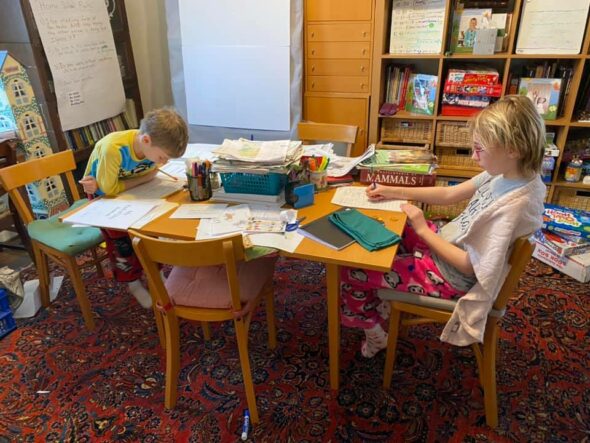
Mills Lawn students Henrick Cain, Anastasia Mayer and Henry Campbell, pictured here in September, were in a K-3 pod in the Mills Lawn School gym as part of the Safe Centers for Online Education. (Photo by Carol Simmons)
2020 Year in Review: Village Schools
- Published: January 7, 2021
Calendar year 2020 began and ended with Yellow Springs school district leaders discussing identified structural needs in the local school buildings and how to address them, but the majority of the year was occupied by the district’s response to the COVID-19 pandemic.
Learning amid COVID
Gov. Mike DeWine was at the forefront in national responses to the novel coronavirus pandemic when in March he temporarily shuttered businesses and activities in Ohio, including all K–12 schools, to help curtail spread of the disease.
DeWine announced the school closures Thursday, March 12, effective at the end of the school day Monday, March 16, and initially set the return date for Monday, April 6. In Yellow Springs, one of those three weeks was already designated as the district’s annual spring break, and so teachers and administrators used the four days between the governor’s announcement and the shutdown to prepare two weeks worth of remote-learning and study materials. Teachers set up an online presence to share assignments and answer questions, but new instruction was temporarily suspended during that time. The district also used that period to come up with a plan to continue remote learning should the shutdown be extended, as many anticipated.
The closure continued, first through the end of April, and then through the end of the school year. The school board also began conducting all of its meetings online through a livestream on the district’s Youtube channel.

Levi and Paige Clark are pictured in their dining room — which, in April, was the new school room — completing work in their jammies. (Submitted photo)
For the remainder of the academic year, the district adopted an online-learning model that used a weekly themed question as an organizing principle for assignments and study. Teachers at the middle and high schools formed teams for thematic instruction, and specific classes, including physics and foreign languages, were discontinued. Given the stresses on students and families, the superintendent sought to end the year two weeks early, in mid-May, when the state’s required number of instructional hours had been reached, but the Ohio Department of Education, or ODE, didn’t approve the action.
Anticipating a healthier landscape by the scheduled late-August start of the 2020–21 school year, the board in early July approved a plan to begin the new academic year with students back in the buildings, where a variety of COVID-related safety protocols were to be instituted.
A midsummer surge in the number of area COVID cases, however, led district leaders to rethink their plan. The district also reported a positive case among staff members. Then, bolstered by survey results from families and a town hall meeting with the superintendent conducted online, along with a public statement by the teachers union calling for a delay in a return to in-person classes, the district held a special meeting in late July to approve pushing back the start date for students by a week, to Aug. 27, and beginning the year with 100% online instruction, at least through the first quarter. The approach was to be more comparable to typical in-person schedules and classroom structures than the model used in the spring. The district also introduced a plan for a limited number of students, whose families could not oversee their children’s home-based online instruction because of jobs or other circumstances, to gather in small, supervised groups in the school buildings for what they called Safe Centers for Online Instruction, or SCOL.
In October, the school board approved the continuation of 100% online instruction for the second quarter, scheduled Monday, Nov. 2, through Friday, Jan. 15, 2021. The district also implemented a program to allow a limited number of invited students into the schools on Wednesdays for one-on-one tutoring and/or counseling. By mid-fall the other six districts in Greene County had all returned to a full, five-day, in-person schedule, leaving Yellow Springs the only one to remain online. But the surging number of cases throughout the county, as well as positive cases within other districts’ schools, prompted most of them to adopt a temporary online model or a hybrid approach, combining in-person and online instruction, by the end of the calendar year.
At the local school board’s last regularly scheduled meeting of 2020 on Dec. 10, Superintendent Terri Holden introduced a hybrid plan for returning Yellow Springs students to their classrooms part time, once certain criteria concerning community spread of the disease are met. While the transition plan is ostensibly effective with the start of the second semester, Tuesday, Jan. 19, 2021, Holden said she does not anticipate any kind of return that soon, as the conditions remain far from desirable.
Food program
Throughout the statewide school closures last spring, and then through the summer and fall, Yellow Springs Schools continued providing breakfasts and lunches to students who qualify for free or reduced-price meals as well as students whose families expressed a need. Since spring, district staff have made home deliveries twice a week, with enough meals for each child in the recipient household and to cover the days in between deliveries. Throughout the spring, the Community Foundation and local food bank provided dinners with the deliveries as well.

(Submitted photo)
Facilities
Following its annual organizational meeting on the second Thursday of January, the school board started 2020 with a work session Jan. 11 to discuss district facilities. The meeting came as the 11-member facilities task force prepared to report in February on its final recommendations after meeting regularly for nearly a year.
At the board’s work session, the superintendent said she anticipated putting a new levy request — a second try after voters rejected a previous attempt in May 2018 — before voters in November 2021. Board members discussed such possible actions as the potential sale of district property, a reconsideration of Ohio Facilities Construction Commission, or OFCC, funding and a re-examination of the benefits of a K–12 campus. Holden, who had been part of the facilities task force, told the board that the group’s members supported a phased approach for addressing building needs, but she disagreed with that conclusion. Such an approach would cost the district more money over time, she believed, and also would involve paying for maintenance on obsolete structures, which she considered wasted dollars.
In February, the task force, which included community members, some of whom had voted against the previous levy effort, along with district staff and administrators, gave its final report, recommending an increase in funding and staffing for building maintenance as well as listing priority needs at both campuses. The group, however, stepped back from recommending how the district should approach the upgrades, whether phased or all at once.
The high-priority needs cited included replacing the modular classrooms on both campuses as well as improving overall security. The task force also called for upgrades to the building “envelope” (outside walls and doors, roof and windows); the plumbing, electric, heating and cooling systems; and the kitchens and cafeterias.
At its regularly scheduled meeting in March, the board voted to pursue potential funding by the OFCC. Then the COVID shutdown hit, and the facilities discussions were set aside.
A board work session Saturday, Nov. 21, picked up where the district left off. Holden reiterated her desire to put a bond issue before voters in the 2021 general election, and laid out a timeline for getting there, including community meetings early in the coming new year. The minimum price tag for any project — whether new construction, renovation or a combination — would be about $30 million, Treasurer Tammy Emrick projected.
The board held a special meeting Dec. 28 to approve a pre-bond architect, selecting the SHP firm, based in Cincinnati, which will work with the district to develop a master plan.

Graduating senior Eric Hansen showed his class pride during a car parade through town for 2020 graduates that led into the Antioch University Midwest parking lot for an outdoor “drive-in” commencement ceremony May 27. (Photo by Kathleen Galarza)
Other school news
• School board membership: The board’s first meeting of 2020 opened with the swearing in of Sylvia Ellison and TJ Turner to new four-year terms, the two having run as unopposed incumbents in November 2019. Board members also re-elected Steve Conn as board president and Aïda Merhemic as vice president for the year. Also on the board is Steve McQueen.
• Fostering more teachers of color: In January, the district launched the practicum part of a partnership with Wittenberg University to identify, mentor and train college students of color interested in becoming teachers, when three Wittenberg students began coming into the schools and shadowing Yellow Springs teachers. The program, called the Teacher Pipeline Initiative, was supported by a grant from the Ohio Department of Education.
• Mindfulness programs: In January, the News reported that three months after introducing mindfulness activities, led by high school intervention specialist Donna Haller, as an alternative to some detentions — guided meditation on Mondays and yoga on Wednesday — at the middle and high school campus, participating students were enjoying the opportunities to calm their minds, and the schools were benefiting from the positive effects on behavior.
• State voucher program: Early in the year, Ohio lawmakers debated the state’s voucher program, titled EdChoice, which allows students in schools that have been designated as “underperforming,” based on standardized testing results, to attend qualifying private, including parochial, schools, with subsidies paid by their home district. The issue hit home when it was learned that the state had listed Mills Lawn Elementary School as an underperforming school based on the improvement scores for early at-risk readers. The school most recently had earned an NR, or not rated, for the 2018–19 school year, because there were too few early at-risk readers to count. State testing was canceled for the 2019–20 year because of the pandemic-related school closings.
• Mourning a beloved community member: The entire school community grieved after beloved bus driver Darryl Dewer, known simply as “Mr. Darryl,” died suddenly Feb. 11, from an apparent heart attack, while picking up students in the high school parking lot. In order to honor the “great guy with a big heart,” the school initiated a new annual memorial scholarship in Dewer’s name, recognizing a graduating senior’s community service.
• District and former teacher settled suits: In February, the school district and former district teacher Angela Bussey, who taught health and physical education at McKinney Middle School for the 2013–14 school year, reached a settlement in a civil suit and subsequent countersuit filed in spring 2018. The school district initially sought $25,000 in damages, alleging that Bussey, using a pseudonym, had made false statements about school administrators on social media and broken the terms of a previous settlement with the district, finalized in spring 2015, by commenting on it publicly. Bussey countersued for $100,000, claiming that the district had not upheld its part of the earlier agreement, and that details about that settlement were already known publicly. While the new settlement did not assign fault to either side, it included the stipulation that the district pay $7,500 to Bussey in reimbursement for her legal fees.

An unidentified student had his temperature taken by school nurse Charlyn Cantrell before entering Mills Lawn School on Friday morning, Sept. 18. The district requires everyone going into the schools to have a temperature check before entering. (Photo by Carol Simmons)
• Administrative and staff changes: In April, longtime Mills Lawn Principal Matt Housh announced his plan to leave the district at the end of the school year for an administrative position as head of curriculum with Huber Heights Schools in Montgomery County.
In a special school board meeting May 20, the district hired Michelle Person, a principal and former teacher from Cleveland who has authored diversity-themed children’s books and has a background in theater, as Mills Lawn’s new head. Her starting salary, according to district records, was $108,174 a year.
Also new to the district for the 2020–21 school year was Candice Teague, teaching fourth grade at Mills Lawn, and Cameron Dickens, teaching science at the middle school.
Retiring at the end of December are longtime intervention specialist Linda Kalter, who served the local district for 22 years, and instructional aide Constance Richeson, who has been with Yellow Springs Schools for 12 years.
• Graduation: Sixty-five seniors received their diplomas May 28 in an outdoor “drive-in” ceremony in the Antioch University Midwest parking lot, following a car parade through town. Zoe Clark and Julia Hoff, chosen by a committee of teachers and administrators, were the student speakers. In pre-taped talks displayed on a large screen, the two young women focused their remarks on themes of resilience and hope. A drive-through outdoor event at Mills Lawn the day before recognized sixth graders who would be moving up to the middle school the following school year.
• Antiracism team formed: Inspired by local youths leading weekly rallies and marches this summer, seeking accountability and change concerning systemic racism within local and national institutions, the district formed an antiracism team at the beginning of the school year. Actions included a staff reading of Ibram X. Kenti’s “How to be an Antiracist,” and the distribution of a survey to gather stories of Black experiences in the schools.
• Financial forecast: Prepared each fall and updated in spring for submission to the county auditor, the district’s most recent five-year forecast, presented to the school board in November, showed a widening gap between revenues and expenses, with the district’s cash balance going under the desired 30-day operating balance in fiscal year 2022, and then falling into a negative balance of more than $74,000 by fiscal year 2024.
• Track and field repairs: Long-awaited repairs to the high school track and field began in late October and continued through November. Phase one of the project included removal of the top layer of the track surface; removal and relocation of the long jump runways, the pole vault runway and pad and the shot put area; removal of the scoreboard and soccer goals; and the correction of drainage issues. Initial work on the project was expected to cost the district a little over $400,000.

Antonia Varandani-Smith gets comfortable during an online Antioch School lesson. (Submitted Photo)
Antioch School
• New Younger Group teacher: In January, the News visited with the Antioch School’s new Younger Group teacher, Elaina Vimmerstedt. A 2016 graduate of Wittenberg University with a background in music and outdoor education, Vimmerstedt said she’d found an educational model at the nearly 100-year-old independent school that matches her own ideals about child-centered learning.
• March COVID shutdown: Along with other Ohio K–12 schools, The Antioch School closed in March for a pandemic-related shutdown that eventually extended through the remainder of the school year. Teachers reached out to their students in a variety of ways to support continued learning at home.
• A return to school: The school community decided to return to in-person instruction with the start of the new school year the first week in September, but with a number of safety protocols in place. Primary among them was to move classes outdoors as much as possible. Air filtration units also were installed in each classroom, and students had limited contact with others outside their own groupings.
• An extended break: With a staff member testing positive for COVID-19 during the Thanksgiving break, the school decided to extend the class break through the December holidays. It plans to start online in January, continuing until conditions related to the pandemic improve.
Community Children’s Center
• A five-star rating: In early March, the Children’s Center learned that it had been newly designated by the state as a five-star child-care facility. The five-star label is the highest possible rating assigned by Step Up to Quality, a statewide quality rating and improvement system administered jointly by the Ohio Department of Education and the Ohio Department of Job and Family Services. The local facility previously had one star, which it briefly lost during a turbulent time in the center’s history about five years ago, so a jump to five stars was “huge,” according to center Director Malissa Doster.
• COVID-related closure: The Children’s Center administration decided in March to close the local daycare center temporarily, rather than continue operation as a designated “pandemic child-care” facility. The facility’s last day for the duration of the state-ordered shutdown of all other daycare operations was Wednesday, March 25. The state had approved the center, which serves about 85 children from infancy to 12 years of age, for a pandemic child-care license, but facility staff did not feel comfortable with the restrictions and the risks. The Center resumed operations after the state allowed all daycares to reopen May 31, and has yet to have a recorded case of COVID-19.
The Yellow Springs News encourages respectful discussion of this article.
You must login to post a comment.
Don't have a login? Register for a free YSNews.com account.















No comments yet for this article.